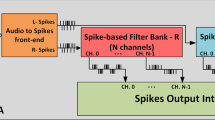Abstract
In speech processing applications, the instantaneous bandwidth of speech can be used to adaptively control the performance of an audio sensor’s analog front end. Extracting the instantaneous bandwidth of speech depends on the detection of speech edges in the time–frequency plane. In this paper, we propose a spike encoding circuit for real-time and low-power speech edge detection. The circuit can directly encode the signal’s envelope information—an important feature to identify the speech edge—by temporal spike density without additional envelope extraction. Furthermore, the spike encoding circuit automatically adapts its resolution to the amplitude of the input signal, which improves the encoding resolution for small signal without increasing the power consumption. We use the nonlinear dynamical approach to design this circuit and analyze its stability. We also develop a linearized model for this circuit to provide the design intuition and to explain its adaptive resolution. Fabricated in 0.5-μm CMOS process, the spike encoding circuit consumes 0.3-μW power and the experimental results are presented.















Similar content being viewed by others
References
Smith, E. C., & Lewicki, M. S. (2006). Efficient auditory coding. Nature, 439, 978–982.
Smith, L. S., & Fraser, D. S. (2004). Robust sound onset detection using leaky integrate-and-fire neurons with depressing synapses. IEEE Transactions on Neural Networks, 15, 396–405.
Ghitza, O. (1986). Auditory nerve representation as a front-end for speech recognition in a noisy environment. Computer Speech and Language, 1, 109–130.
Ren, Y., & Johnson, J. M. (2009). Auditory coding based speech enhancement. In Proceedings of the IEEE International Conference Acoustics, Speech and Signal Processing (ICASSP), 4685–4688.
Uysal, I., Sathyendra, H., & Harris, J. G. (2007). Spike-based feature extraction for noise robust speech recognition using phase synchrony coding. In Proceedings of the IEEE International Symposium Circuits and Systems (ISCAS), 1529–1532.
Mino, H. (2007). Encoding of information into neural spike trains in an auditory nerve fiber model with electric stimuli in the presence of a pseudospontaneous activity. IEEE Transactions on Biomedical Engineering, 54, 360–369.
Du, D., & Odame, K. (2011). Efficient speech edge detection for mobile health applications. In Proceedings IEEE Biomedical Circuits and Systems Conference (BioCAS), 45–48.
Hu, G., & Wang, D. (2007). Auditory segmentation based on onset and offset analysis. IEEE Transactions on Audio, Speech and Language Processing, 15, 396–405.
Du, D., & Odame, K. (2011). A bio-inspired ultra-low-power spike encoding circuit for speech edge detection. In Proceedings IEEE Biomedical Circuits and Systems Conference (BioCAS), 289–292.
Du, D., & Odame, K. (2012). An adaptive microphone preamplifier for low power applications. In Proceedings IEEE International Symposium Circuits and Systems (ISCAS), 660–663.
Indiveri, G., Chicca, E., & Douglas, R. (2006). A VLSI array of low-power spiking neurons and bistable synapses with spike-timing dependent plasticity. IEEE Transactions on Neural Networks , 17, 211–221.
Gouveia, L. C., Koickal, T. J., & Hamilton, A. (2011). An asynchronous spike event coding scheme for programmable analog arrays. IEEE Transactions on Circuits and Systems—I: Regular Papers, 58, 791–799.
Delbruck, T., Koch, T., Berner, R., & Hermansky, H. (2010). Fully integrated 500uW speech detection wake-up circuit. In Proceedings of the IEEE International Symposium on Circuits and Systems (ISCAS), 2015–2018.
Tsividis, Y. (2010). Event-driven data acquisition and digital signal processinga tutorial. IEEE Transactions on Circuits and Systems—II: Express Briefs, 57, 577–581.
Tsividis Y. (2010) Event-driven data acquisition and continuous-time digital signal processing. In Proceedings of the IEEE Custom Integrated Circuits Conference (CICC), pp.1–8.
Buchler, M. C. (2002). Algorithms for sound classification in hearing instruments. Ph.D. Dissertation, ETH Zurich, Zurich, Switzerland.
Goodman, D. (1969). Delta modulation granular quantizing noise. Bell System Technical Journal, 48, 1197–1218.
Kalman, R. E., & Bertram, J. E. (1960). Control system analysis and design via the “second method" of Lyapunov—I: continuous-time systems. Journal of Basic Engineering and Transactions of the ASME, 82, 371–393.
Weik, M. H. (2000). Computer science and communications dictionary (vol. 2, p. 1901). Norwell, MA: Kluwer Academic Publishers.
Sandlin, R. E. (2000). Textbook of hearing aid amplification (pp. 78–80). San Diego, CA: Singular Publishing Group.
Acknowledgments
This work was supported by the Neukom Institute at Dartmouth College and National Science Foundation under Grant ECCS-1128478.
Author information
Authors and Affiliations
Corresponding author
Rights and permissions
About this article
Cite this article
Du, D., Odame, K. An energy-efficient spike encoding circuit for speech edge detection. Analog Integr Circ Sig Process 75, 447–458 (2013). https://doi.org/10.1007/s10470-013-0041-y
Received:
Revised:
Accepted:
Published:
Issue Date:
DOI: https://doi.org/10.1007/s10470-013-0041-y




